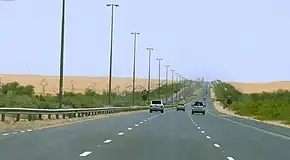E 66 road (United Arab Emirates)
E 66 (Arabic: إ ٦٦) is a road in the United Arab Emirates. The road connects the city of Dubai to the interior city of Al Ain in the Eastern Region of the Emirate of Abu Dhabi. E 66 runs roughly perpendicular to E 11 (Sheikh Zayed Road) and E 311 (Sheikh Mohammad Bin Zayed Road Road). Beginning in the locality of Oud Metha, E 11 progresses southward towards the interior. The road is referred to as the "Dubai-Al Ain Road", after its intersection with Emirates Road south of the city of Dubai, and "Tahnoun Bin Mohammad Al Nahyan Road", after Sheikh Tahnoun, the Ruler's Representative in the Eastern Region of Abu Dhabi.[1]
 | |
|---|---|
| إ ٦٦ | |
 E 66 becomes Dubai – Al Ain Road south of Dubai | |
| Route information | |
| Length | 127.7 km (79.3 mi) |
| Major junctions | |
| Location | |
| Country | United Arab Emirates |
| Major cities | Dubai, Al Ain |
| Highway system | |
Description
It goes through the towns of Al-Faqa' (shared by the Emirates of Abu Dhabi[2] and Dubai)[3] and Al-Hayer,[2] and connects to Al Madam in the Emirate of Sharjah via Al-Shwaib.[1] Once in Al Ain, a city that shares a border with Oman, the road becomes Emirates Street and later, Bani Yas Road.
Exits
| Exit Number | Description |
| 1 | E 11 (Sheikh Zayed Road) |
| 6 | E 44 (Ras Al Khor Road) |
| 9 | Nad Al Sheba Racecourse |
| 14 | E 311 (Sheikh Mohammad Bin Zayed Road) |
| 16 | Dubai International Academic City/Academic City Road |
| 18 | E 611 (Emirates Road) |
| 26 | Umm Nahad |
| 29 | E 77 (to Jebel Ali and Abu Dhabi) |
| 30 | E 77 (to Hatta and Oman) |
| 37 | Al Lusayli |
| 47 | Margham and Dubai Desert Conservation Reserve |
| 50 | Marquab and Dubai Desert Conservation Reserve |
| 50 | Marquab and Dubai Desert Conservation Reserve |
| — | Shwaib, Al Fujairah and eastern towns |
| — | Al-Hayer, Al Sweihan |
| — | Al Kira'a, Bida bin Ahmed |
| — | Al Ain Dairy |
| — | Al Foah, Al Ain City |
History
In 2010, authorities in the Emirates of Abu Dhabi revamped the road in two phases. The first phase contained 3 lanes in each direction, and stretched 23 km (14 mi) from Al-Towayya to Al-Masaken. The second phase contained 4 lanes in each direction, and stretched 42 km (26 mi) from Al-Masaken to Al-Faqa'. In November 2018, under the directives of Sheikh Mohamed bin Zayed Al Nahyan, the road was renamed after Sheikh Tahnoun.[1]
In 2022, authorities undertook a project worth $ 544.9 million[4] or AED 2 billion[5][6] to improve the traffic flow in Dubai. Spanning 17 km (11 mi) from the intersection with the road to Ras Al-Khor to the intersection with the Emirates Road, the highway was widened from 3 lanes on each side to 6 lanes on each side,[7] or 12 lanes in total,[6] and 6 main interchanges were built. The interchanges stretch for 11.5 km (7.1 mi), and have ramps and bridges.[4] This part of the highway was opened by Sheikh Hamdan bin Mohammed Al Maktoum on Sunday the 29th of May.[5][7]
See also
References
- "Dubai-Al Ain Road renamed". WAM. Al Ain: Gulf News. 2018-11-02. Retrieved 2018-11-04.
- "Eastern Region Bus Services", Department of Transport, Government of Abu Dhabi, archived from the original on 2018-05-24, retrieved 2018-11-04
- "Dubai: Crime and accidents down in Al Faqa". Gulf News. 2014-04-14. Retrieved 2018-09-09.
- Tolentino, Julianne (2022-06-01). "Launch of $544.9mn Dubai-Al Ain Road Improvement Project to "enhance human welfare"". Construction Week. Retrieved 2023-09-12.
- "Sheikh Hamdan opens Dh2 billion Dubai-Al Ain motorway". The National. 2022-05-29. Retrieved 2023-09-12.
- Cassidy, Matt (2022-05-31). "Dubai to Al Ain: A new 12-lane motorway has been officially opened". Yalla Dubai. Retrieved 2023-09-12.
- Masudi, Faisal (2022-05-29). "How newly opened Dubai-Al Ain Road will benefit you". Gulf News. Dubai, the U.A.E. Retrieved 2023-09-12.